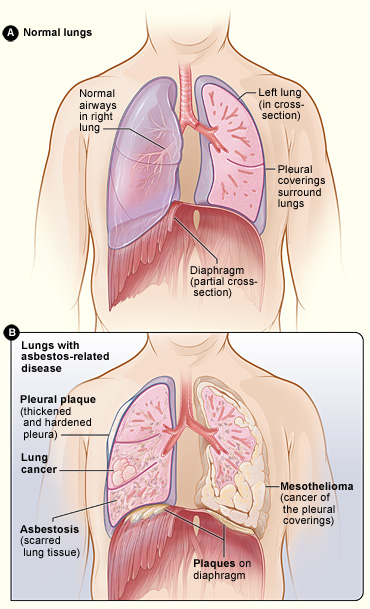
Asbestos is a common word commonly used for referring to six naturally occurring silicates minerals. Each mineral is composed of a series of long and short fibrous crystalline fibres, each fibre being made up of numerous microscopic ‘fibers’ which can release into the air when abrasion is applied and other mechanical processes take place. They are resistant to heat, fire, cold and most chemicals, but asbestos fibers are very sensitive to heat, and will be destroyed quickly if exposed to these elements.
In addition to being extremely elastic, they also create a lot of tension in the fibers, creating an incredibly strong material. As such, they constitute the bulk of building materials and structures, including ceiling panels and cladding for pipes and ventilation systems.
Asbestos fibers can be found in many places, from roofing materials, floor tiles and ceilings to insulation and fire insulation, and many people have had contact with asbestos during their lives. This is largely due to the fact that asbestos is a natural material, and the production of these fibers is not an invention of modern science.
Unfortunately, when people suffering from asbestos develop asbestos (asbestos), which is pneumonia caused by the release of asbestos fibers into the air, doctors must determine that asbestos exposure has occurred or it could have happened. it is impossible to prove that the person contracted asbestosis. This makes the process very difficult and requires careful testing.
While there is no evidence that asbestos is actually directly responsible for causing or starting lung cancer, it is generally believed to be a factor because people who are frequently exposed to asbestos are much more likely to develop some form of cancer, especially lung cancer. This is not due to an innate genetic predisposition, but because the risk of contracting the disease increases with age.
Certain groups of individuals, especially those that suffer from chronic diseases such as lung ailments, have a higher chance of contracting the disease, while others have a lower risk. It is believed that asbestos exposure may increase your chance of developing lung cancer by 50%, although this isn’t considered a solid basis for a definite connection. Asbestos particles have been linked to several forms of cancer in the past, although conclusive proof has yet to be found.
The symptoms of lung cancer in the lungs include coughing, wheezing, shortness of breath, chest pains and fatigue, and often, these symptoms may develop suddenly. If any of the above mentioned symptoms are present, you should get yourself checked out immediately by a medical professional.
A medical professional will test the air in your home and then conduct a specific test to determine if asbestos is present, whether it is through a simple questionnaire or a physical test. The reason for this test is to identify the type of asbestos that is present, and then it is removed from the environment or disposed of. It is extremely difficult to remove the asbestos in your home if you aren’t aware of its presence.
You may be exposed to asbestos through common household items such as carpets, rugs, furniture and ceiling tiles, which can come from both manufactured and natural sources. You are also at risk of developing lung problems if you inhale asbestos fibers into your lungs while bathing or working with asbestos-containing materials.
There are numerous ways in which asbestos can accumulate in your body. These include inhalation of the fibers, ingestion of them, and absorption through the skin, and even in direct contact with the fibers themselves. The best way to prevent this is to take precautions to avoid inhaling the fibers, avoiding situations where you may be exposed to these fibers, such as remodeling a building, cleaning your house, or renovating your home.
The inhalation of these airborne fibers may be most dangerous to individuals who are susceptible to lung infections from bacteria. The effects of asbestos exposure can range from shortness of breath, irritation of the lining of the lung, and coughing. If the material is breathed in, a person will generally experience immediate symptoms such as irritation, soreness, and chest pains, even if they’re not experiencing pain with their eyes or mouth. These symptoms may be severe and should not be ignored.
When individuals develop lung cancer as a result of inhaling the fibers, the chances for survival are relatively high; however, it is not likely to become malignant. However, it is very important for individuals to consult a medical professional and have them perform a test to determine if they have been exposed to asbestos. This is especially true if they are diagnosed with other diseases such as mesothelioma, as asbestos may be a cause.